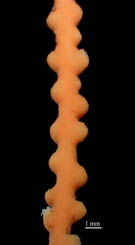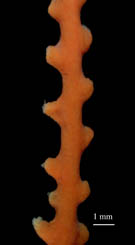CONTENTS
Introduction
The South Atlantic Bight
Methods
Octocoral Morphology
Glossary
Gorgonacean
Bauplan
see this for keys
Notes on the Species
Carijoa
riisei
Scleranthelia
rugosa
Telesto fruticulosa
Telesto nelleae
Telesto sanguinea
Bellonella rubistella
Pseudodrifa nigra
Nidalia occidentalis
Iciligorgia schrammi
Diodogorgia
nodulifera
Titanideum
frauenfeldii
Muricea pendula
Thesea nivea
Bebryce cinerea
Bebryce parastellata
Scleracis guadalupensis
Paramuricea sp.
Leptogorgia hebes
Leptogorgia punicea
Leptogorgia
cardinalis
Leptogorgia virgulata
Leptogorgia setacea
Leptogorgia euryale
Viminella
barbadensis
Renilla reniformis
Sclerobelemnon
theseus
Stylatula elegans
Virgularia presbytes
| Guide
to the Shallow Water (0-200 m) Octocorals of the South Atlantic
Bight.
S. T. DeVictor
& S. L. Morton, 2007
Viminella
barbadensis Remarks. Viminella barbadensis is one of several ellisellid species that have been the subject of reclassification in the last two decades. Bayer and Grasshoff (1994) suggested that unbranched species of Ellisella be placed into the genus Viminella based on Kukenthal’s (1924) classification,and that Viminella [Ellisella]is a subgenus of Ctenocella. Grasshoff (1999) removed the subgenus status and placed ellisellids with unbranched growth forms (“whips”) under the genus Viminella, establishing the basis for the new combination presented in this document.
|
|
 |



